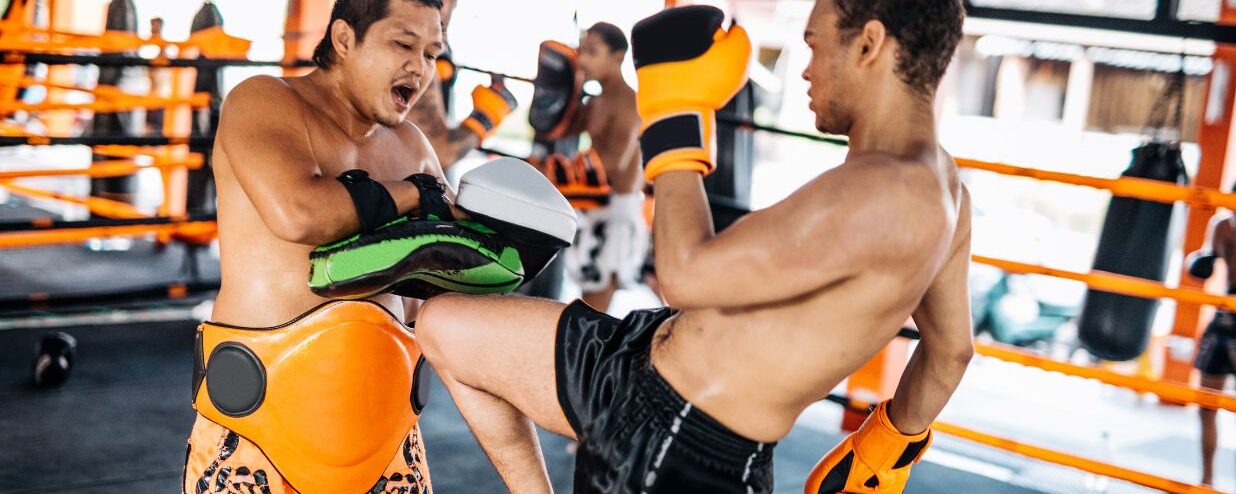When you think of Japan, it’s impossible not to imagine the rich culture of martial arts that has existed in this country for centuries, so, it’s no wonder that combat sports is thriving here. Japanese martial arts has played a pivotal role in the development of many modern combat sports such as mixed martial arts (MMA) and kickboxing. From home-grown disciplines such as Judo, to imported arts like boxing, the country has established itself as one the world’s best places to train in martial arts as displayed by its impressive roster of talent.
Doing Combat Sports in Japan: How Safe Is It?
Before we dive into the multitudes of martial arts Japan has to offer, you are probably (and reasonably) concerned about the risk of injury and whether safety is up to standard here. Especially since most combat sports consist of some level of physical contact, it is important to consider the risks and how to best reduce them.
Safety And Injury
Combat sports consists of varying degrees of physical contact which are categorized by the following conventions:
- Light-contact: involves very light attacks that shouldn’t be more than just tapping the opponent. Generally, light-contact is used for training or sparring to help develop skills while preventing injury when making mistakes. This is especially useful for absolute beginners.
- Semi-contact: involves strikes and attacks with firmer contact but never with full force. Knocking out or attempting to knock out an opponent is strictly forbidden. Most sports use semi-contact sparring as a form of training. There are also quite a few martial arts that have competitions with semi-contact rules such as Karate and Taekwondo.
- Full-contact: Strikes and attacks are full force, usually with the intention of knocking out or hurting the opponent. This form of contact has the highest risk of injury and is rarely used in training. Many martial arts competitions use full-contact rulesets such as Muay Thai, boxing, Judo, etc.
You probably know the word, sparring (randori or masusupaa in Japanese), a free form mock fight with an opponent. Its purpose is to train and develop your skills in a safe environment where your opponent is trying to resist your techniques and vice versa without the risk of serious injury. With that in mind there are actually quite a few unwritten rules to ensure everyone is as safe as possible while also getting the most out of the training.
Sparring Etiquette
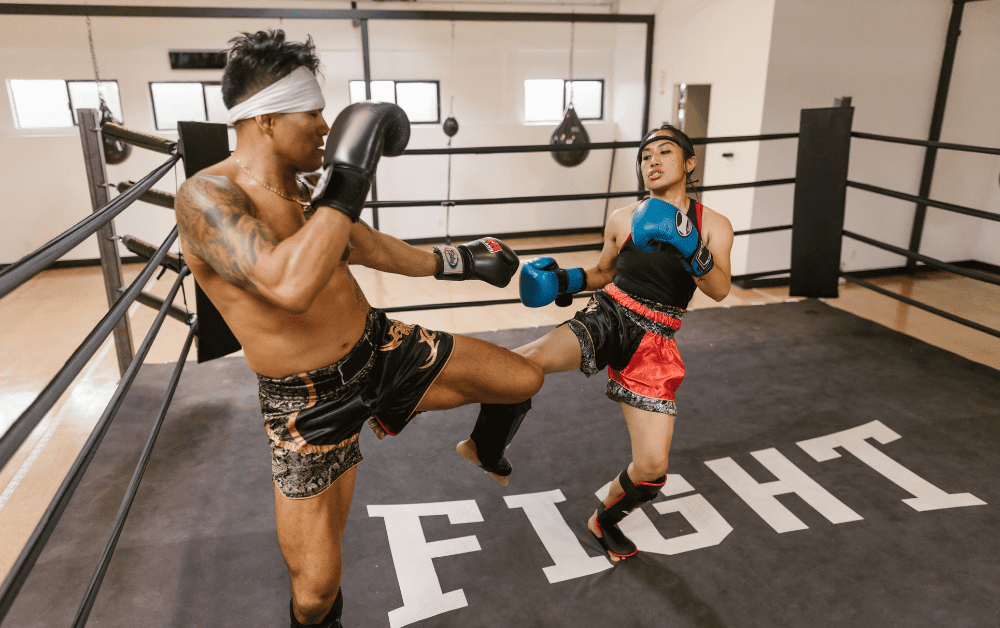
Different disciplines and schools/gyms will likely have their own codes to follow but the intention of sparring at its core is to improve yourself and your partner’s skills. It is not meant for you to knock your partner’s head off. As a general rule of thumb, light to semi-contact should be the hardest amount of force for striking sports. Training etiquette is fundamentally about considering your partner and others as you will see in the small list of unwritten rules provided below:
| Combat Sport Type: | Codes of Etiquette to Keep in Mind: |
| Grappling arts (Judo, Brazilian Jiujitsu, etc.) | Sparring is full-contact since you’re applying full force to throw or submit your partner but this does not mean you should be reckless |
| Avoid neck cranks | |
| Always slowly apply submissions (chokes, arm locks and joint locks) | |
| Be aware of forbidden techniques and never use them | |
| Striking arts (Muay Thai, boxing, etc.) | Sparring is usually light to semi-contact, so do not go above 50% strength unless specifically asked to do hard sparring |
| Never hit around the groin area | |
| If you feel your partner is putting too much weight behind his strikes, politely ask him to tone it down by saying: “もう少し軽くお願いします(mou sukoshi karuku onegaishimasu)” | |
| General | Try to cut your nails and toenails |
| Respect the rules of the gym and especially your Senseis (it is especially important in Japan) | |
| Take off shoes and socks before entering the training area – this is purely for hygiene reasons since people are rolling on the ground |
What to Avoid – Red Flags When Doing Combat Sports In Japan
Japan prides itself on its safety and this extends to the martial arts schools and gyms here. However, there are some that do, unfortunately, fall short of basic standards. So, whenever you come across any of the following, you should walk out the door:
- Body hardening training consisting of taking hits to the head. (Will increase chance of brain injury)
- Lack of urgency, knowledge, or ability to deal with injuries. (If someone gets hurt, they should be taken care of immediately)
- Engaging in training methods that could be dangerous or risks the safety of others. (Toxic sparring environments, choking someone to sleep, usage of dangerous techniques, etc.)
How Much Japanese Is Needed For Combat Sports In Japan?
Practicing martial arts and combat sports in Japan is one of the best ways to experience the culture, learn something truly life-changing, and even practice some Japanese. Due to the repetitive nature of training, you will inadvertently drill some useful language as well. Below are some words to know that you will likely be drilling with your techniques.
Daijoubu(大丈夫) Is One Word You Likely Use A lot. Check Out Our Video On How To Use It:
Body Parts
If you are going to learn combat sports, you will need to know what body parts you will be attacking or attacking with:
| Japanese | Pronunciation | English |
| 頭 | あたま atama | Head |
| 胸 | むね mune | Chest |
| 腕 | うで ude | Arm |
| 足 | あし ashi | Leg/Foot |
| 足首 | あしくび ashikubi | Ankle |
| 手 | て te | Hand |
| 手首 | てくび tekubi | Wrist |
| 首 | くび kubi | Neck |
| 肘 | ひじ hiji | Elbow |
| 膝 | ひざ hiza | Knee |
| 腰 | こし koshi | Hip |
| 肩 | かた kata | Shoulder |
| 指 | ゆび yubi | Finger |
| 足指 | あしゆび ashiyubi | Toes |
Martial Arts Terminology
When starting combat sports in Japan, there might be some new words you haven’t heard before, so here is a short list to get started:
| Japanese | Pronunciation | English |
| 試合 | しあい shiai | Match/competition |
| 構え | かまえ kamae | Stance |
| 方 | かた kata | Pre-arranged forms |
| 取り | とり tori | Performer of technique |
| 受け | うけ uke | Receiver of technique |
| 受身 | うけみ ukemi | Break falling |
| 寝技 | ねわざ newaza | Ground fighting techniques |
| 立技 | たちわざ tachiwaza | Standing techniques |
| 乱取り | らんどり randori | Free sparring (Judo) |
| マススパー or マス | masusupaa or masu | Light sparring (boxing, kickboxing, etc.) |
| スパーリング | supaaringu | Sparring (kickboxing, boxing, etc.) |
| 組手 | くみて kumite | Sparring/Competition (Karate) |
| パンチ | panchi | Punch |
| 蹴り | けり keri | Kick |
Need to drill Japanese to complement your martial arts training in Japan? Check out our article: Top 100 Basic Japanese Words.
Judo (柔道)
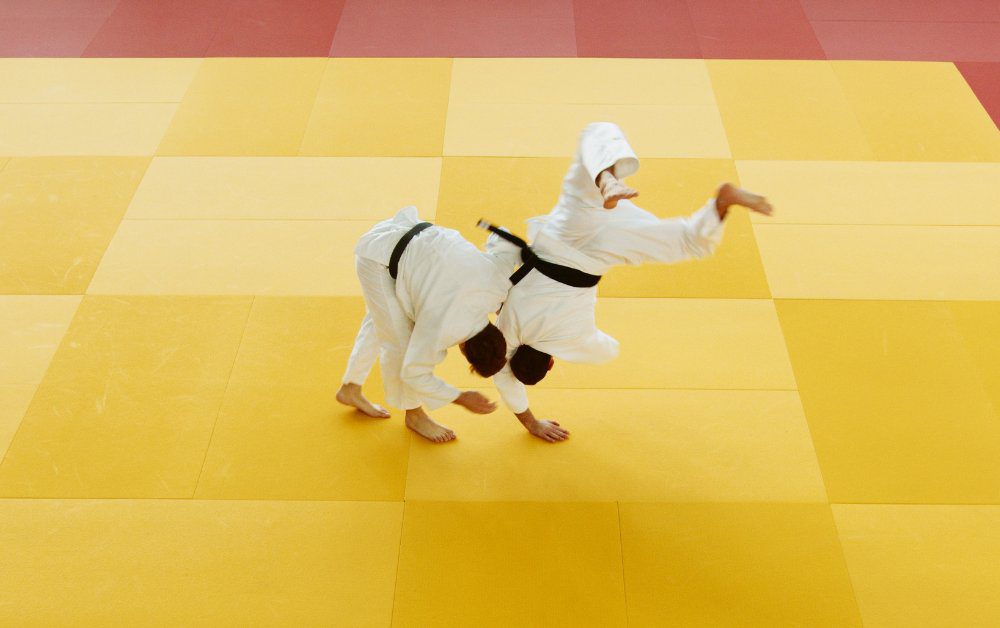
Judo is a traditional Japanese martial art and is one of the most popular combat sports in the world. The word 柔道 (Judo) translates to ‘the gentle way’ which captures the philosophy and methods of the art. Judo emphasizes techniques that manipulate an opponent’s energy, center of gravity, and weight to toss them onto the ground while causing minimal damage. However, the first technique you learn is ukemi (受身), or break falling. This is the most important in preventing injury when you’re on the receiving end of a throw. Beyond Judo, ukemi is a great habit for breaking your fall in any situation.
Training Judo In Japan
If you have experience practicing Judo in other countries, training in Japan may have some noticeable differences especially since its traditions are rooted in the country’s cultural legacy. Before starting and ending each practice, it is customary for all participants to bow on their knees.
As you would expect, Judo training in Japan is some of the best in the world due to the focus on fundamentals. Judo techniques are broadly categorized between tachiwaza (立技 standing techniques) and newaza (寝技 ground techniques). Japan is known for ingraining a strong foundational understanding in both. Of course, you will also be drilling bread and butter techniques that you see in the Olympics. Examples include the Seoi Nage (Shoulder throw), Uchi Mata (inner thigh reaping throw), Osoto Gari (large outer reap throw), etc.
Training at the Kodokan (講道館)
The Kodokan is known as the mecca of Judo as it was established by Jigoro Kano, the founder of Japanese combat sport. It is comparatively more traditional and strict about customs compared to most other Judo associations since it is seen as the golden standard. For instance, you can only train in a white Judo gi, even though blue is common in world competitions.
But, it is one of the most respected institutions to learn and practice Judo. It attracts some of the top talent and trains in the most proper methods for the sport. Judo classes are available which teach you techniques in a structured format. They offer classes for specific ages and skill levels so you can learn at your pace. For adults or more experienced practitioners, you can partake in the randori classes where you freely spar with any opponent you wish. These classes are called ippan (一般).
Accessibility And Price
You can find Judo schools just about everywhere in Tokyo and there is likely a school in your local town in Japan. Judo is probably the most affordable and accessible martial art you will find on this list. Many organizations are part of the All Japan Judo Federation which practices at public neighborhood gymnasiums equipped with a martial arts studio. However, they often only practice 1 to 2 times a week. You can also practice directly at the Kodokan which has practice 6 days a week. Alternatively, you can join private Judo clubs which are closer in price to other disciplines on this list.
| All Japan Judo Federation Affiliated Schools | Private Club | Kodokan | |
| Price: | ¥1500 – ¥5000~ per month or ¥200 – ¥500 per class | ¥10000~ per month | ¥5500 ~ per month or ¥800 per class |
| Accessibility: | All over Japan, you can find dojos here. | Throughout Japan but not as common as the All Japan Judo Federation | Tokyo: 1-16-30 Kasuga, Bunkyo-ku, Tokyo 112-0003 Osaka: 4-15-11 Nagata, Joto-ku, Osaka-shi, Osaka 536-0022 |
| Practice per week: | 1 – 4 times a week | 4 – 6 times a week | 6 times a week |
Competition
Judo has gained a reputation for having a ton of complicated rules such as where you can grip or grab. For instance, grabbing or touching the legs of your opponent is illegal. But this rule is subject to change very soon. It does seem a bit complicated at first but as you practice, you will naturally adjust to the rules.
The goal of Judo is to throw your opponent to the ground, ideally flat on his back. This will count as an Ippon (一本) or the winning point. You can also win with newaza by either pinning the opponent or applying a chock or arm lock.
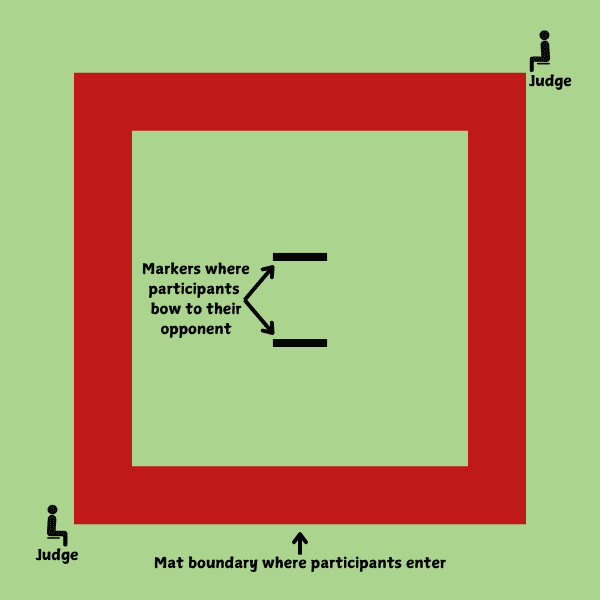
In Japan, competitions are going to be strict on maintaining customs. Before the match, you are to bow before entering the mat followed by walking in with your left leg first. Then you bow again behind the marker to respect your opponent. After the match, you stand in front of the marker, bow to your opponent again and walk backwards starting with your right leg. Once you leave the mat boundary, you must bow yet again.
Karate (空手)
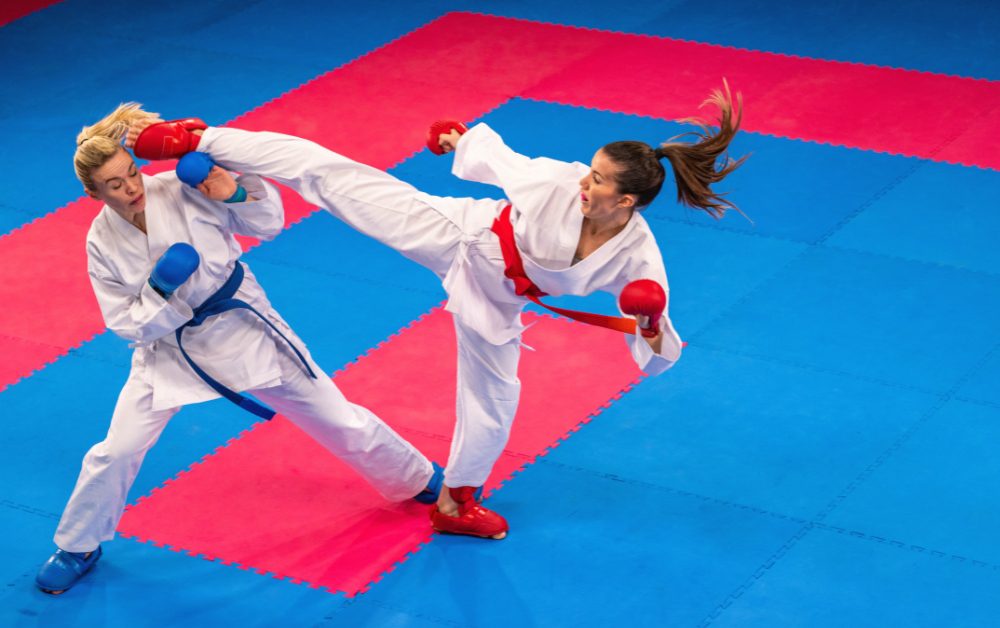
Karate is originally from Okinawa, formerly known as the Ryukyu Islands, and has roots in White Crane Kung-fu since the region historically traded with China. There are several different styles of Karate each differing from each other.
Shotokan (松涛館)
Shotokan is probably the most popular form of Karate in the world as it’s an official olympic sport. The combat sport centers around training in 3 divisions: kihon (basics), kata (pre-arranged forms), and kumite (sparring or competition). Be aware that not all Shotokan Karate schools participate in kumite competitions, schools a part of the JKF (Japan Karate Federation) usually do.
Kihon (基本) and Kata (方)
Karate emphasizes beautiful techniques that create an awe-inspiring whipping sound from the practitioner’s gi (or uniform) when executed elegantly and swiftly. Shotokan Karate consists of a wide variety of basic techniques known as Kihon. These include kicking (front, side, back, hook, etc.), punching, blocking, sweeping, and throwing as well as combinations of these.
Kata is an organized sequence of movements used to help the practitioner practice the techniques and understand how they’re used. Kata is also a popular form of competition for Karate where the goal is to execute form and rhythm perfectly.
Kumite (組手)
Kumite is the term for Karate competition which in training can be light to semi contact. Kumite in the dojo tends to be more free especially for more advanced students where most techniques are allowed within reason.
The actual competition is semi-contact, strikes without enough impact may not count. Once an attack successfully lands on the opponent, the match is reset and the attacker receives a point. You can also score points by knocking down the opponents using sweeps (similar to Judo) but throws are prohibited.
Kyokushin (極真)
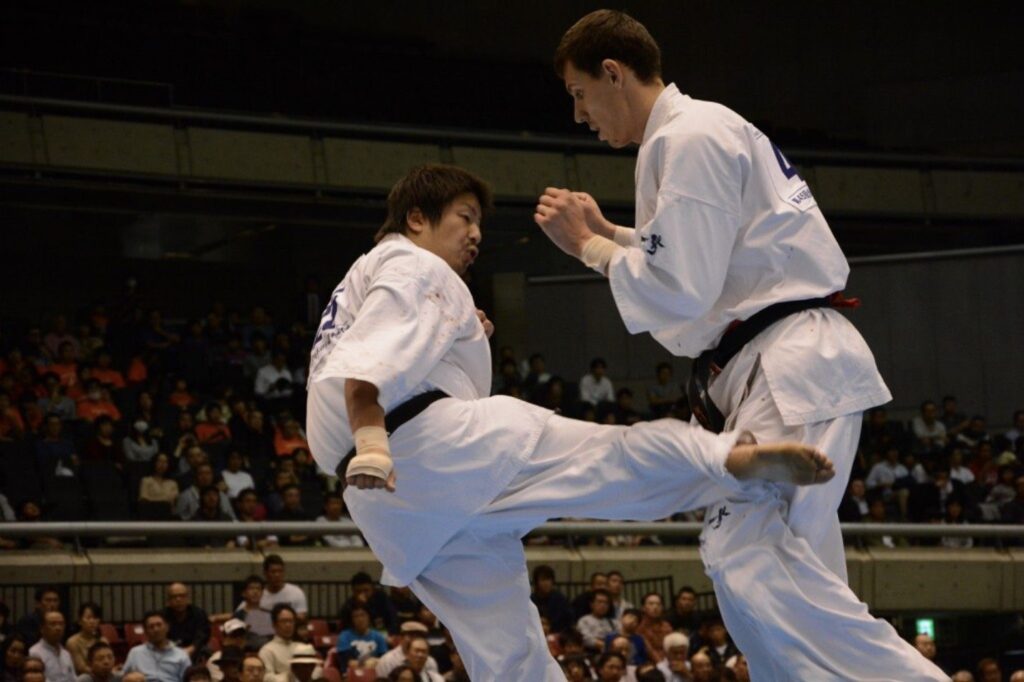
Kyokushin might be the second most popular Karate style in the world. Many fighters in the UFC have trained in this discipline, such as George St. Pierre. Kyokushin is known to be the hardest form of Karate focusing on strength and challenging the will of the human spirit.
Kyokushin shares the same training triangle as Shotokan: kihon, kata and kumite. The techniques are quite distinct as Kyokushin was inspired by other Okinawan arts. Also the competition consists of full contact rules where knock out is the ultimate win.
Training And Kumite
Much of the training revolves around giving and taking bare knuckle punches to the core and chest area. This is because the Kumite allows punches to the body but not to the head. However, kicks to the head, body, inner and outer thighs are permitted. Depending on the tournament rules, knockdowns via sweeps are also allowed. Kyokushin practitioners are most popular for their beautiful and yet dangerous axe kicks and spinning hook kicks. Those with backgrounds in Kyokushin often display these impressive techniques in other combat sports like kickboxing.
Traditional Okinawan Karate
Traditional Okinawan styles have persisted through the years and are still some of the most popular disciplines of Karate. They give practitioners a glimpse into an older Karate culture that has some roots to traditional Okiwanan culture. These more classical arts stresses self defence such as hardening knuckles through hitting wooden slabs or techniques like eye-gouging. Some of these training methods may seem dated for self defense in a modern context but there are aspects which can be useful.
In terms of sparring and training for combat sports, some of these schools do participate in Shotokan kumite. While others, in line with its self-defence approach, train in informal full-contact sparring matches while wearing protective gear.
3 Popular Styles of Okinawan Karate Include:
- Goju-ryu (剛柔流)
- Shorin-ryu (少林流)
- Uechi-ryu (上地流)
Accessibility And Price
Shotokan and Kyokushin are the most popular styles of Karate and the easiest to find across Japan. The Okinawan schools might be in most big cities or scattered across the country. The price will likely vary from school to school but on average the monthly fees will likely be around ¥5000 to ¥10,000 per month. Some schools will charge fees per class which could be around ¥2000 per visit.
Kickboxing And Muay Thai
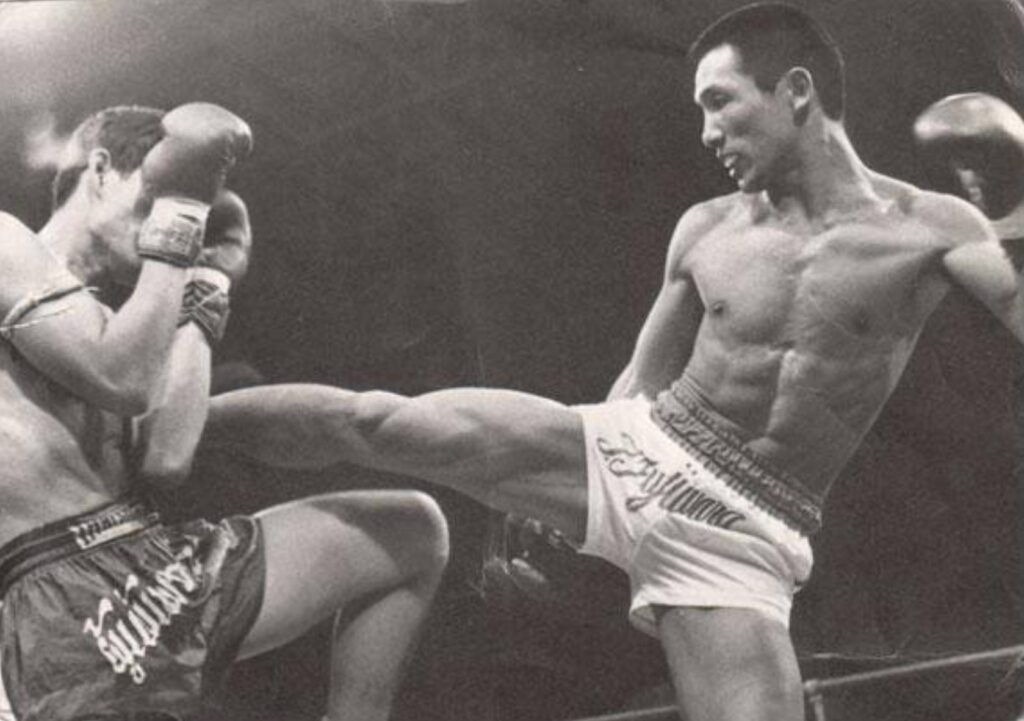
Some years ago, there was a rivalry between Karate (Kyokushin) and Muay Thai. This led to 3 Karate representatives traveling to Thailand to challenge 3 Muay Thai Fighters. Out of these matches, only one Karate practitioner lost, Kurosaki. He took this defeat to lay the foundations of kickboxing by combining Muay Thai and Karate techniques. His student, Toshio Fujiwara, went on to make history when he was the first non-thai to win the Muay Thai championship at the esteemed Rajadamnern Stadium.
Kickboxing vs Muay Thai – Different Combat Sports?
Kickboxing as we know it today, was largely developed in Japan through a mix of Karate (mostly Kyokushin), boxing and Muay Thai. Japan’s popular combat sports promotions, such as K-1, ushered Kickboxing into the global stage. Resulting in them establishing the most widely recognized rule sets in the world today. Now, the biggest promotions such as One Championship, Glory, and Bellator use these rules.
Kickboxing and Muay Thai have a lot in common but there are some major differences in rules. Kickboxing promotions wanted the competition to be heavier in punches and other flashy striking techniques. Conversely, due to Muay Thai’s rules, there are long sequences of clinching (upper-body grappling) and elbowing disincentivizing long punch combinations. Other styles of kickboxing exist, however, in Japan most gyms will adhere to the rules pioneered by their nation.
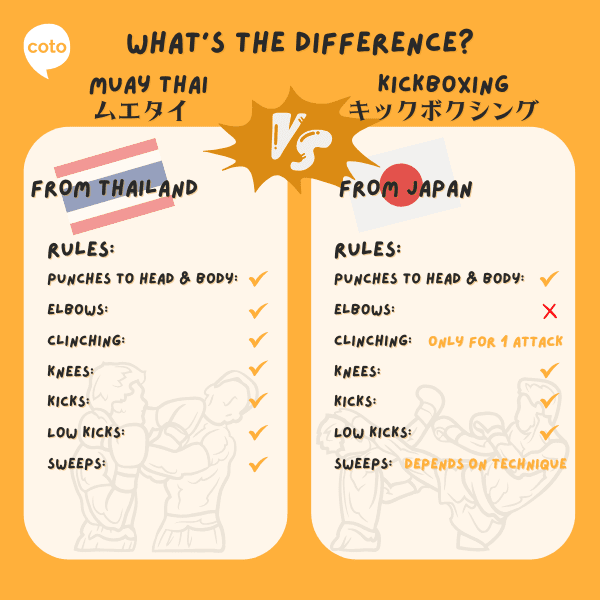
Which Is Harder? Which Is Right For Me?
They are both combat sports that share a common history so the training methods are very similar especially since kickboxing adopted much of the same training as Muay Thai. They both consist of a lot of pad work, punching bag training, kick training, shadow boxing and sparring.
Sparring is one area where the two could differ. Muay Thai prioritizes flow sparring or light sparring allowing practitioners to focus on technique and skills. In kickboxing, it might be more common to engage in harder sparring. Both spar light to semi-contact for the most part but competition will be full contact depending on the skill level (beginners may have more protective gear and rules).
They are both great for exercise such as increasing endurance, strength, flexibility and mobility. Keep in mind, kickboxing can also refer to the exercise circuit training meant purely for fitness and has nothing to do with the combat sport.
Availability and Price
Kickboxing studios and Muay Thai gyms are all over the country as they are very popular combat sports in Japan. In Tokyo, there is likely a location that is a train or bus ride away from your home.
Most gyms are privately ran and must operate their facilities since public ones don’t really exist for the sport. These higher overhead costs contribute to the higher price to join and train in Muay Thai and Kickboxing. On average monthly fees will be around ¥10,000 ~ ¥15,000.
Boxing
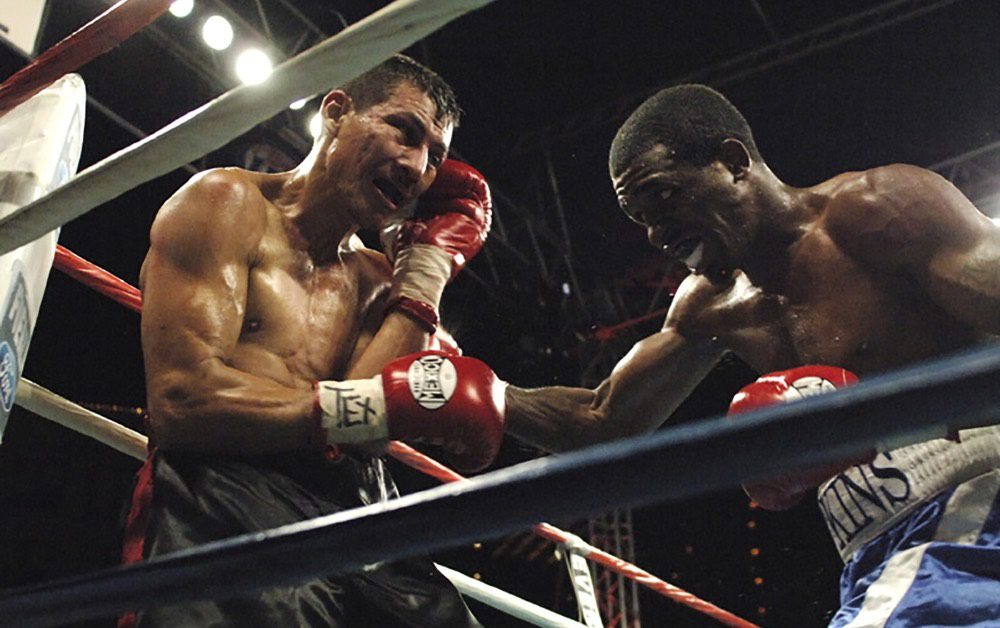
Japan has truly cemented itself as one of the top countries in boxing boasting numerous talents like Naoya Inoue who currently holds 4 world champion belt titles. The nation has also shown its infatuation for the sport with some their most popular pop culture creations like the anime, Hajime no Ippo or the classic game, Punch Out, being solely about the sport of boxing.
Training In Boxing In Japan
Despite the lack of coverage Japanese boxers receive in countries like the U.S. which tends to concentrate on heavier weight classes, the country produces some of the greatest boxers ever with a plethora of high level gyms especially in Tokyo.
Boxing, like many other combat sports, has a long history of being in Japan. As a result there are several gyms teaching very traditional training methods coupled with exploring newer, innovative approaches. Many coaches here really nurture your skills in the combat sport due to their extensive experience. You can even train at the gyms that produced Japan’s world champions but these gyms will likely be more expensive due to the demand.
Price And Availability
Boxing is very popular in Japan so there is plenty of supply to meet this demand. You will find plenty of boxing gyms in big cities and there are likely at least a couple in smaller towns.
The average price of boxing gyms can vary with the gyms known for training the champions, usually over ¥20,000 a month. However, most gyms fall around ¥10,000~ per month. Boxing, like kickboxing/Muay Thai, are mostly private gyms which is why the price is generally higher than sports like Judo.
Kendo And Weapon Based Combat Sports In Japan
When the samurai reigned over Japan, mastering martial arts in weaponry was essential for battle and duels, and the practice of these disciplines still exist today. Many of these arts became combat sports where techniques from the old practices have been adapted using protective equipment and bamboo, wooden, or soft weapons.
Kendo (剣道)
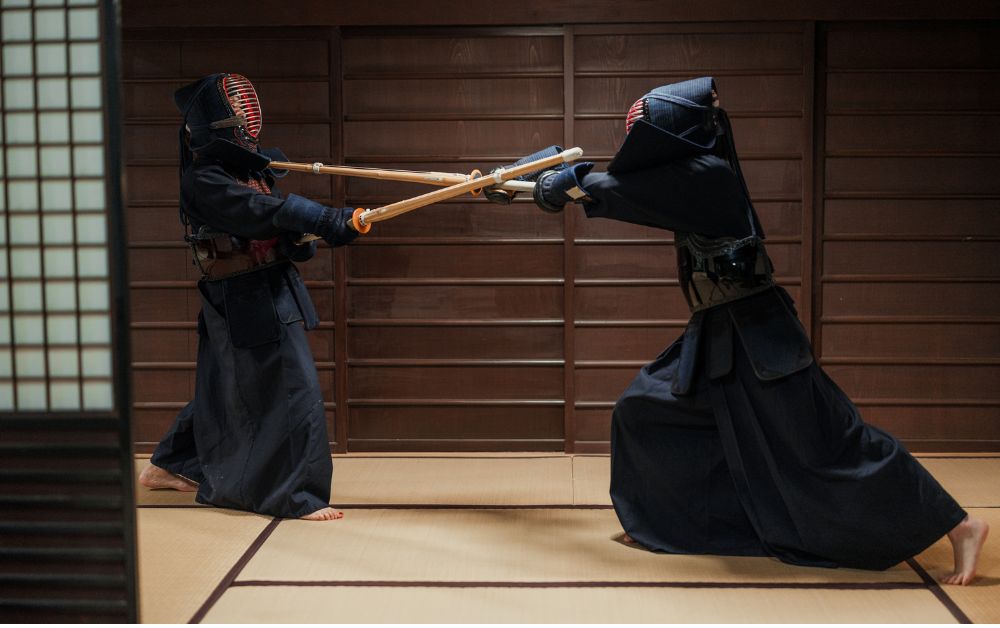
Kendo is the most popular both domestically and abroad, and the name translates to the ‘way of the sword’. It comes from Japan’s history of developing their distinct swords and martial arts to use them. Kendo is the modern sportified version of this tradition where practitioners use bamboo blades, called a Shinai, and wear protective equipment. Points are scored by hitting specific targets: the top of the head (men), torso (do), wrist (kote), and throat (tsuki).
Naginata (長刀)
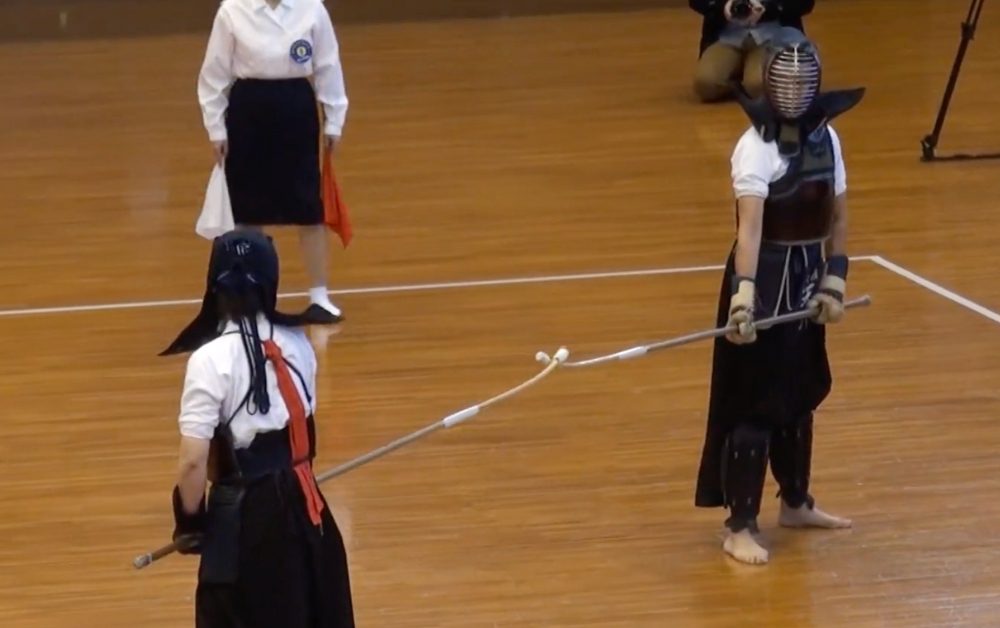
Atarashii Naginata (New Naginata) or simply Naginata is a combat sport and martial art similar to Kendo. They use the same type of protective armor and often train in the same locations. The biggest difference is that this combat sport employs a weapon called the naginata (a bladed polearm similar to a glaive). Like Kendo, they use a bamboo version of the weapon and score points by hitting different targets on the opponent.
Practicing Kendo And Naginata
Practicing Kendo or Naginata will give incredible insight into the history and cultural traditions of Japan. In Naginata, you can use a real naginata to perform different forms taken from the historical techniques practiced by samurai or you can partake in the combat sport where you duel an opponent.
Many universities have clubs that offer Kendo classes and to a lesser extent, Naginata. You can find organizations across Japan which often have practice at gymnasium martial arts halls. On average the price will be around ¥2000 to ¥5000 yen per month.
Other Weapon Combat Sports In Japan
Chambara is another weapon based combat sport based on historical martial arts of Japan and is gaining some popularity globally. This sport uses foam like weapons, instead of bamboo which makes for a safe and fun way to learn traditional Japanese martial arts. They have swords, staff, and spear-like weapons of varying sizes. This sport is harder to find in comparison to other arts on the list, however, practice tends to be pretty affordable.
Although Kendo and Naginata derive from methods of the samurai, the process of adapting into a modern sport resulted in losing certain practical and traditional aspects of the techniques. This is where Kenjutsu and Iado come in as these martial arts are dedicated to preserving historical techniques employed by the samurai. Although they are not considered combat sports, it is a great way to dive deeper into Japanese culture while developing a new skill in a beautiful art form.
Brazilian Jiu Jitsu
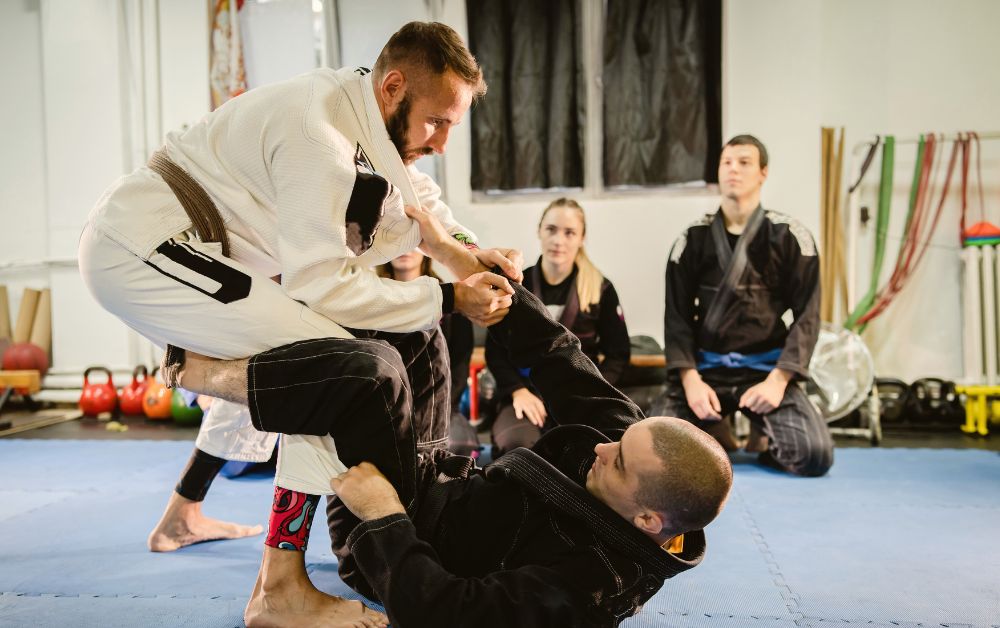
Brazilian JiuJitsu or BJJ is one of the most popular combat sports in Japan possibly be due to its close relationship with Judo. BJJ is a grappling art which emphasizes newaza, from Judo. The art is the best to train for mastering ground fighting techniques.
Training in BJJ in Japan
In many cities in Japan, you might find more BJJ schools than Judo, including famous franchises found across the globe such as Carpe Diem or Gracie University schools (exactly 3 in Japan). BJJ is also often offered as additional classes in other martial arts gyms such as Muay Thai, MMA, or Judo.
Training mostly focuses on ground techniques especially in submissions such as chokes, arm and leg locks. And possibly the most important aspect, their innovative guard techniques where you lie on your back trapping your opponent with your legs.
Sparring and sparring drills are vital to the combat sport and usually make up a large portion of the practice. This may sound very intense if you’re not used to sparring a lot but BJJ is known for their more relaxed approach, similar to Muay Thai. The goal is to improve skills rather than just trying to win as quickly as possible. This is not to say sparring does not get intense or push you physically.
Price And Availability
As mentioned, BJJ is widely available and easier to find compared to Judo. This is because many Judo clubs practice in public gymnasiums where BJJ are privately run gyms that need to be in areas easier to find. As a result, BJJ tends to be on the pricier end at around ¥11,000 ~ ¥18,000 per month.
MMA and Hybrid Combat Sports In Japan
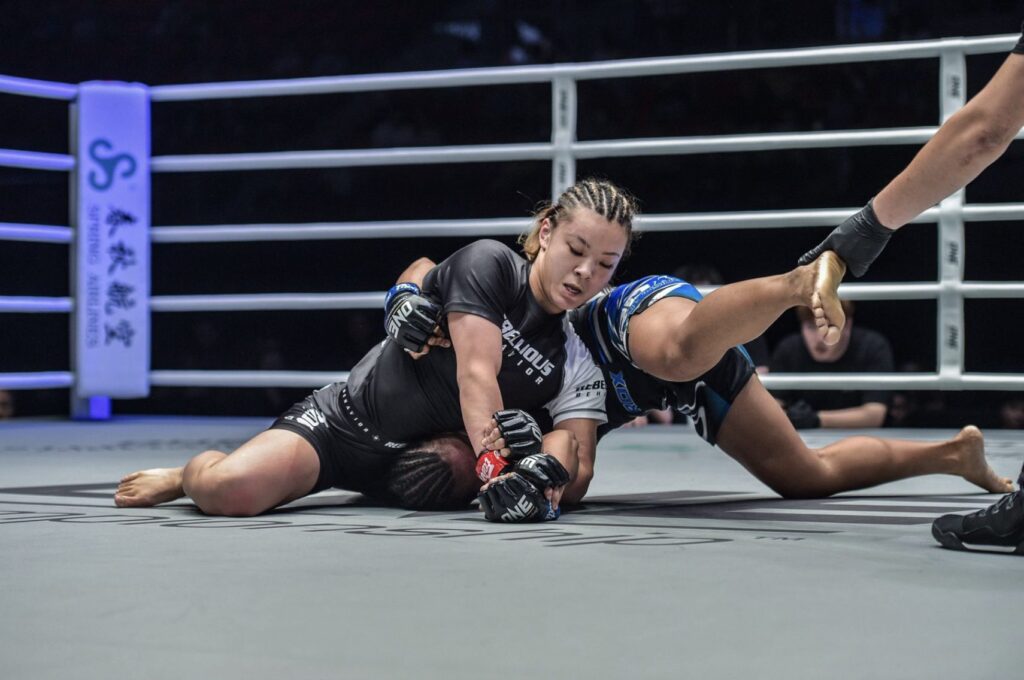
Japan has been integral to the evolution of many combat sports and MMA is without doubt one of them. From the influence of techniques from Karate and Judo used in modern MMA to creating some of the biggest promotions that hosted very influential fights to the sport, Japan’s impact is innumerable. The country is continuing to produce some amazing talent and is one the best places to train in MMA.
Training MMA in Japan
Japan has founded some of the world’s most popular MMA promotions such as Pancrase, Rizin, Shooto and the former Pride Fighting Championships. So, you can expect the country to be one of the best places to train in MMA.
But what is MMA exactly?
MMA is a full-contact combat sport best described as a single discipline that draws upon a variety of different martial arts from grappling (wrestling, judo, BJJ) to striking arts (Muay Thai, boxing, kickboxing, karate, etc.). Thus the name, Mixed Martial Arts.
In most MMA gyms, training is divided into classes teaching a specific art. For instance, morning time slots could be kickboxing where evening is BJJ. There are also classes that drill techniques specifically for MMA such as combining wrestling takedowns with punches.
In Japan, you will find unique gyms that draw on Japan’s traditional martial arts culture coupled with coaches who focus on refining technical skills. You can expect some of the highest quality MMA training that is modern yet draws upon the martial arts philosophies developed over Japan’s vast experience in combat.
Hybrid Martial Arts And Combat Sports In Japan
MMA is the most recognized hybrid combat sport but Japan is known for having their own home grown hybrid martial arts which compete in their own tournaments with specific rule sets.
One Japanese hybrid art gaining a lot of awareness is Daido Juku (大道塾) or Kudo (空道). It is a full contact combat sport distinct from MMA since the rules require participants to wear specialized head gear designed to prevent head trauma as well as a gi similar to Judo. Due to the helmets, you are allowed to headbutt and punch to the face. Kudo derives most of its techniques from Judo and Karate but practitioners from other disciplines also train and participate.
Availability and Price of MMA/Hybrid Arts
Both as a popular combat sport and a growing hobby, you can find a plethora of MMA and hybrid martial arts gyms throughout Japan. On average gyms will be over ¥10,000 a month. Bigger MMA gym brands are around ¥11,000 ~ ¥15,000 or ¥20,000~ for access anytime.
Final Thoughts On Starting Combat Sports In Japan
Training in martial arts and combat sports in Japan is one of the best ways to experience the culture, get in shape and even practice some Japanese. Participating in more traditional arts will immerse you in Japan’s rich culture as you will need to learn the customs. This includes bowing to your opponent and always showing respect whether you win or lose during competition. I think this might contrast with western competition where trash talk is not only allowed but encouraged.
To start in most combat sports gyms, initial costs can get expensive depending on the gym and discipline ranging from ¥4000 ~ ¥11,000. Plus sports insurance which is not too high, usually under ¥2000 yen.
Practicing martial arts and any sport in Japan can be great way to build up your Japanese language skills, since you are actually drilling words along with the techniques and actions you are doing. To further your immersion of the language, try out our classes and practice what you learn in the dojo (not the fighting techniques).
Whether you are in Japan or not, you can learn Japanese with us either online or in one of our schools in Tokyo and Yokohama.
FAQ
What is the most popular Combat Sport in Japan?
Sumo is the most viewed combat sport in Japan but Karate has the most participants in the country.
What is a Japanese fighting sport?
Japanese fighting sports in terms of combat sports born in Japan include: Sumo, Judo, Kickboxing, some styles of Karate, and many others.
Is MMA legal in Japan?
Yes, MMA is legal in Japan and has been since around the 1980s, if not earlier. Japan is home to many MMA promotions such as Rizin, Shooto, Deep, Pancrase, etc.
What are some famous combat sports?
Famous combat sports include: MMA, Muay Thai, Kickboxing, Judo, Karate, BJJ, Wrestling, and a whole lot more. Some are more famous in certain regions than others.
What is the Japanese version of Kung-fu?
A Japanese martial art called Shorinji Kempo is a Japanese reading of Shoalin Kung-fu (少林寺拳法). Though they are quite different now, Shorinji Kempo directly comes from Shaolin teachings and techniques.
